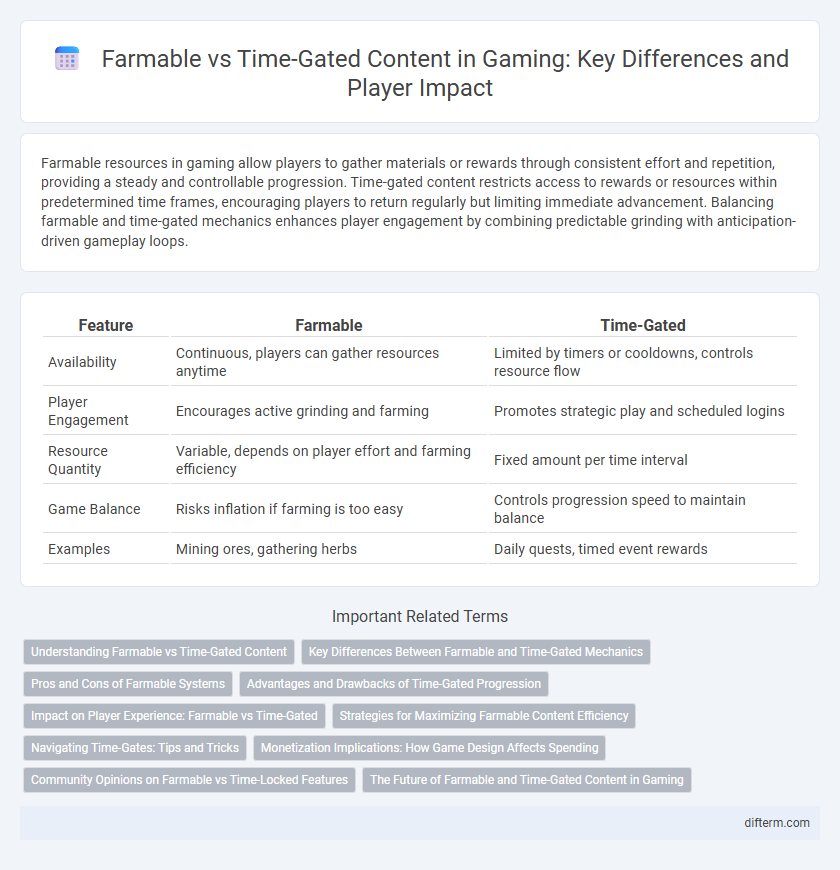Farmable resources in gaming allow players to gather materials or rewards through consistent effort and repetition, providing a steady and controllable progression. Time-gated content restricts access to rewards or resources within predetermined time frames, encouraging players to return regularly but limiting immediate advancement. Balancing farmable and time-gated mechanics enhances player engagement by combining predictable grinding with anticipation-driven gameplay loops.
Table of Comparison
| Feature | Farmable | Time-Gated |
|---|---|---|
| Availability | Continuous, players can gather resources anytime | Limited by timers or cooldowns, controls resource flow |
| Player Engagement | Encourages active grinding and farming | Promotes strategic play and scheduled logins |
| Resource Quantity | Variable, depends on player effort and farming efficiency | Fixed amount per time interval |
| Game Balance | Risks inflation if farming is too easy | Controls progression speed to maintain balance |
| Examples | Mining ores, gathering herbs | Daily quests, timed event rewards |
Understanding Farmable vs Time-Gated Content
Farmable content in gaming allows players to repeatedly gather resources, experience points, or items through consistent gameplay, promoting steady progression and skill development. Time-gated content restricts access to certain rewards or events based on real-world time intervals, creating scarcity and encouraging daily engagement. Understanding the balance between farmable and time-gated mechanics is essential for optimizing game progression and maintaining player motivation.
Key Differences Between Farmable and Time-Gated Mechanics
Farmable mechanics allow players to repeatedly gather resources or rewards through consistent gameplay without strict limitations, fostering a steady progression. Time-gated mechanics restrict access to content or rewards based on real-world time intervals, creating scarcity and encouraging players to return regularly. The key difference lies in player control: farmable systems depend on effort and skill, while time-gated systems depend on patience and timing.
Pros and Cons of Farmable Systems
Farmable systems in gaming allow players to acquire resources or items through continuous play, promoting player engagement and rewarding dedication without enforced waiting periods. These systems foster a sense of progression and avoid frustration typically associated with time-gated mechanics, which may limit access to content through cooldowns or timers. However, farmable systems can lead to repetitive gameplay loops and potential imbalance if rare items become too accessible, diminishing the value of in-game achievements.
Advantages and Drawbacks of Time-Gated Progression
Time-gated progression in gaming controls player advancement by limiting access to resources or levels over set time intervals, fostering long-term engagement and reducing burnout. This mechanic can enhance player retention by encouraging daily logins and creating anticipation, but it may also cause frustration due to prolonged waiting periods that disrupt game flow. Balancing time gates with meaningful rewards is crucial to maintaining player interest without sacrificing pacing or satisfaction.
Impact on Player Experience: Farmable vs Time-Gated
Farmable game mechanics allow players to accumulate resources through consistent effort, fostering a sense of progression and rewarding dedication. Time-gated systems, which restrict access to content or rewards based on real-world timers, can create anticipation but often lead to player frustration due to enforced waiting periods. Balancing farmable and time-gated elements is crucial to maintaining engagement and ensuring a satisfying player experience in gaming environments.
Strategies for Maximizing Farmable Content Efficiency
Maximizing farmable content efficiency requires prioritizing high-yield activities with repeatable rewards to accumulate resources faster. Implementing optimized farming routes and leveraging game mechanics like cooldown resets or boost events significantly accelerates progress. Balancing time investment with resource output ensures steady advancement without the frustration of waiting for time-gated unlocks.
Navigating Time-Gates: Tips and Tricks
Maximizing progress in time-gated games requires strategic prioritization of tasks that refresh or reset frequently, ensuring constant resource accumulation. Utilizing offline time effectively by planning farmable activities aids in maintaining steady growth without being bottlenecked by cooldowns. Monitoring in-game event schedules and optimizing resource usage prevents idle waiting, enhancing overall gameplay efficiency.
Monetization Implications: How Game Design Affects Spending
Farmable game mechanics encourage continual player engagement by offering abundant in-game resources, which reduces the urgency to spend real money, but can increase long-term retention and microtransaction frequency. Time-gated systems restrict resource acquisition through timers, incentivizing players to make purchases to bypass wait times and accelerating monetization. Balancing farmable and time-gated elements directly impacts player spending behaviors and overall game revenue strategies.
Community Opinions on Farmable vs Time-Locked Features
Community opinions on farmable versus time-gated features in gaming often highlight player preference for farmable mechanics due to their rewarding sense of progression and control. Farmable items allow continuous engagement by enabling players to accumulate rewards through skill and effort, fostering a dedicated player base. Conversely, time-gated features can create frustration by limiting access and pacing gameplay artificially, though some players appreciate the structured challenge and anticipation they generate.
The Future of Farmable and Time-Gated Content in Gaming
Farmable content in gaming allows players to earn rewards through continuous effort, promoting sustained engagement and player retention over time. Time-gated content introduces scheduled availability, creating anticipation and pacing progression to maintain interest without overwhelming players. Balancing these mechanics will shape future game design by optimizing player satisfaction and monetization strategies.
Farmable vs Time-gated Infographic

 difterm.com
difterm.com